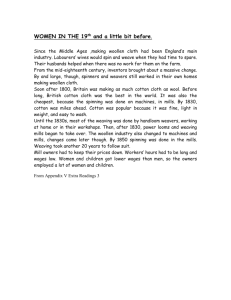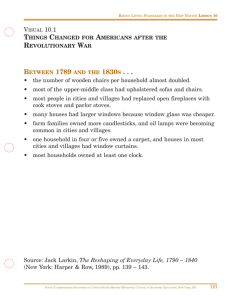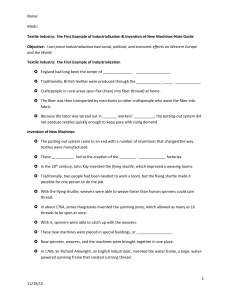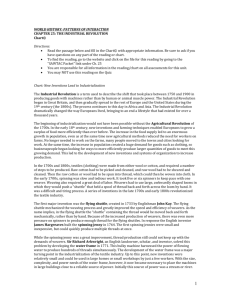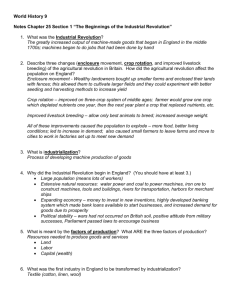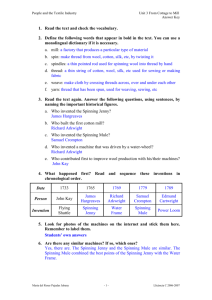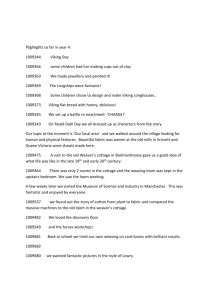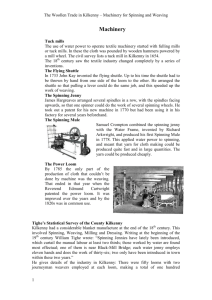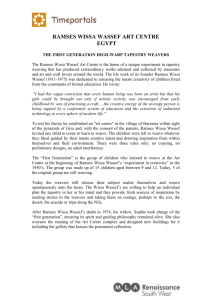William Radcliffe on the effects of technological change in the cotton
advertisement
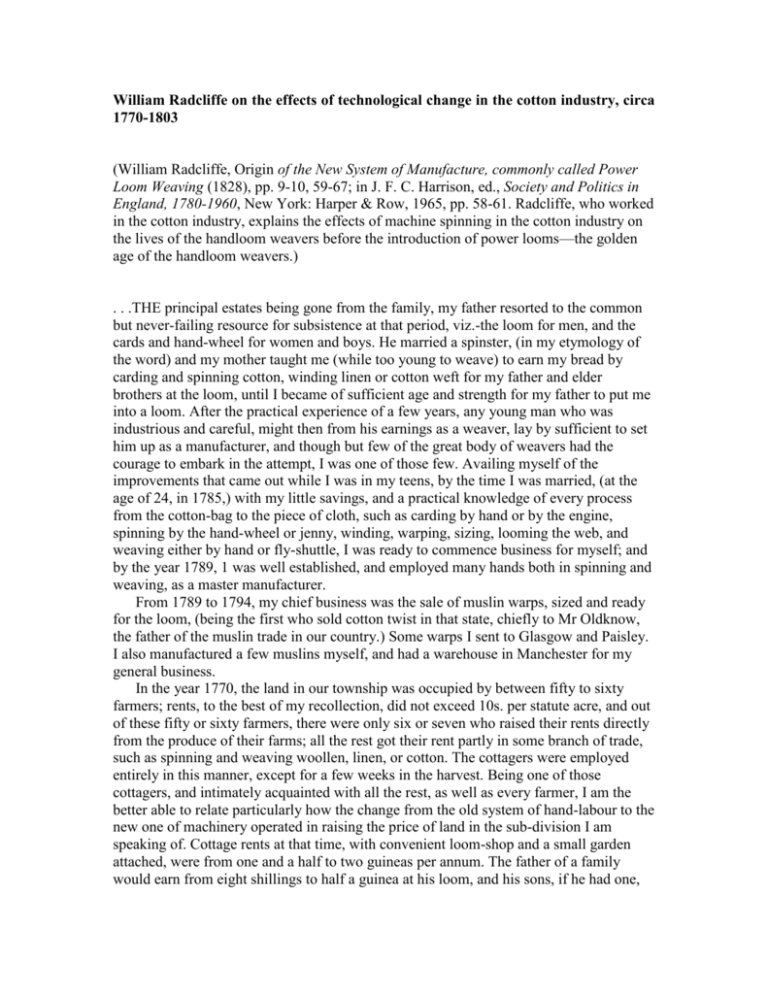
William Radcliffe on the effects of technological change in the cotton industry, circa 1770-1803 (William Radcliffe, Origin of the New System of Manufacture, commonly called Power Loom Weaving (1828), pp. 9-10, 59-67; in J. F. C. Harrison, ed., Society and Politics in England, 1780-1960, New York: Harper & Row, 1965, pp. 58-61. Radcliffe, who worked in the cotton industry, explains the effects of machine spinning in the cotton industry on the lives of the handloom weavers before the introduction of power looms—the golden age of the handloom weavers.) . . .THE principal estates being gone from the family, my father resorted to the common but never-failing resource for subsistence at that period, viz.-the loom for men, and the cards and hand-wheel for women and boys. He married a spinster, (in my etymology of the word) and my mother taught me (while too young to weave) to earn my bread by carding and spinning cotton, winding linen or cotton weft for my father and elder brothers at the loom, until I became of sufficient age and strength for my father to put me into a loom. After the practical experience of a few years, any young man who was industrious and careful, might then from his earnings as a weaver, lay by sufficient to set him up as a manufacturer, and though but few of the great body of weavers had the courage to embark in the attempt, I was one of those few. Availing myself of the improvements that came out while I was in my teens, by the time I was married, (at the age of 24, in 1785,) with my little savings, and a practical knowledge of every process from the cotton-bag to the piece of cloth, such as carding by hand or by the engine, spinning by the hand-wheel or jenny, winding, warping, sizing, looming the web, and weaving either by hand or fly-shuttle, I was ready to commence business for myself; and by the year 1789, 1 was well established, and employed many hands both in spinning and weaving, as a master manufacturer. From 1789 to 1794, my chief business was the sale of muslin warps, sized and ready for the loom, (being the first who sold cotton twist in that state, chiefly to Mr Oldknow, the father of the muslin trade in our country.) Some warps I sent to Glasgow and Paisley. I also manufactured a few muslins myself, and had a warehouse in Manchester for my general business. In the year 1770, the land in our township was occupied by between fifty to sixty farmers; rents, to the best of my recollection, did not exceed 10s. per statute acre, and out of these fifty or sixty farmers, there were only six or seven who raised their rents directly from the produce of their farms; all the rest got their rent partly in some branch of trade, such as spinning and weaving woollen, linen, or cotton. The cottagers were employed entirely in this manner, except for a few weeks in the harvest. Being one of those cottagers, and intimately acquainted with all the rest, as well as every farmer, I am the better able to relate particularly how the change from the old system of hand-labour to the new one of machinery operated in raising the price of land in the sub-division I am speaking of. Cottage rents at that time, with convenient loom-shop and a small garden attached, were from one and a half to two guineas per annum. The father of a family would earn from eight shillings to half a guinea at his loom, and his sons, if he had one, two, or three along side of him, six or eight shillings each per week; but the great sheet anchor of all cottages and small farms, was the labour attached to the hand-wheel, and when it is considered that it required six to eight hands to prepare and spin yarn, of any of the three materials I have mentioned, sufficient for the consumption of one weaver, -this shews clearly the inexhaustible source there was for labour for every person from the age of seven to eighty years (who retained their sight and could move their hands) to earn their bread, say one to three shillings per week without going to the parish. The better class of cottagers and even small farmers also helped to earn what might aid in making up their rents, and supporting their families respectably. . . From the year 1770 to 1788 a complete change had gradually been effected in the spinning of yarns,-that of wool had disappeared altogether, and that of linen was also nearly gone,-cotton, cotton, cotton, was become the almost universal material for employment, the hand-wheels, with the exception of one establishment were all thrown into lumber-rooms, the yarn was all spun on common jennies, the carding for all numbers, up to 40 hanks in the pound, was done on carding engines; but the finer numbers of 60 to 80 were still carded by hand, it being a general opinion at that time that machine-carding would never answer for fine numbers. In weaving no great alteration had taken place during these 18 years, sane the introduction of the flyshuttle, a change in the woollen looms to fustians and calico, and the linen nearly gone, except the few fabrics in which there was a mixture of cotton. To the best of my recollection there was no increase of looms during this period,-but rather a decrease. Although our family and some others in the neighbourbood during the latter half of the time, earned from three to four fold-wages to what the same families had heretofore done, yet, upon the whole, the district was not much benefited by the change; for what was gained by some families who had the advantage of machinery, might, in a great measure, be said to be lost to the others, who had been compelled to throw their old cards and hand-wheels aside as lumber. One of the formidable consequences of this change now began to make its appearance, the poor's rate, which previous to this change had only been known in a comparatively nominal way by an annual meeting at Easter to appoint a new overseer, and the old one to make up his accounts which nobody thought it worth while to look into, as they only contained the expenses of his journey to a petty sessions at a distance, and a few cases of very old persons, 70 to 90 years of age, (whose eyes or hands, failed them) having had a weekly allowance. Relief to persons who could not get employment, or bastardy, were alike unknown on their books, -this I state partly traditionally, and partly from many years under my own observance. There was no material advance in the rent of land or cottages during this period, but in the articles of butcher's meat, butter, cheese, and sundry necessaries of life, there had been some increase of price. The next fifteen years, viz. from 1788 to 1803, which fifteen years I will call the golden age of this great trade, which has been ever since in a gradual decline. . . . ….I shall confine myself to the families in my own neighbourhood. These families, up to the time I have been speaking of, whether as cottagers or small farmers, had supported themselves by the different occupations I have mentioned in spinning and manufacturing, as their progenitors from the earliest institutions of society had done before them. But the mule-twist now coming into vogue, for the warp, as well as weft, added to the water-twist and common jenny yarns, with an increasing demand for every fabric the loom could produce, put all hands in request of every age and description. The fabrics made from wool or linen vanished, while the old loom-shops being insufficient, every lumber-room, even old barns, cart-houses, and out- buildings of any description were repaired, windows broke through the old blank walls, and all fitted up for loomshops. This source of making room being at length exhausted, new weavers' cottages with loom-shops rose up in every direction; all immediately filled, and when in full work the weekly circulation of money as the price of labour only rose to five times the amount ever before experienced in this sub-division, every family bringing home weekly 40, 60, 80, 100, or even 120 shillings per week!!! . . . . . .the operative weavers on machine yarns, both as cottagers and small farmers, even with three times their former rents, they might be truly said to be placed in a higher state of "wealth, peace, and godliness," by the great demand for, and high price of, their Labour, than they had ever before experienced. Their dwellings and small gardens clean and neat, -all the family well clad, -the men with each a watch in his pocket, and the women dressed to their own fancy,-the church crowded to excess every Sunday, -every house well furnished with a clock in elegant mahogany or fancy case,-handsome tea services in Staffordshire ware, with silver or plated sugar-tongs and spoons,-Birmingham, Potteries, and Sheffield wares for necessary use and ornament, wherever a corner cupboard or shelf could be placed to shew them off,-many cottage families had their cow, paying so much for the summer's grass, and about a statute acre of land laid out for them in some croft or corner, which they dressed up as a meadow for hay in the winter.
